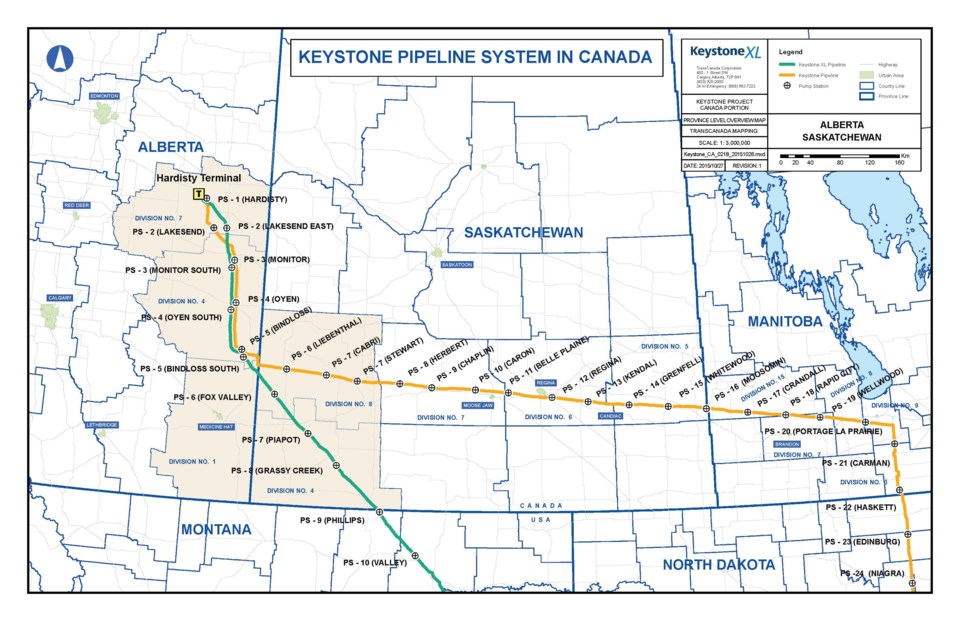One of the first acts of Donald Trump as president of the United States was to invite TransCanada, now TC Energy, to resubmit its Keystone XL pipeline application, and to then approve it.
Now, it is looking like one of the first acts of president-elect Joe Biden, after his inauguration, may be to kill it, and revoke the Presidential Permit for the pipeline to cross the international border, as early as his first day in office.
Biden will be inaugurated on Jan. 20.
The 830,000-barrel per day pipeline is supposed to run from Hardisty, Alta., past Shaunavon, to Steele City, Neb., eventually connecting to the oil hub of Cushing, Ok. The southern portion of the pipeline, which runs from Cushing to the U.S. Gulf Coast, was completed under the Obama administration.
Up to 15 per cent of the pipeline’s capacity had been designated for North Dakota oil production. Current maps don’t show the lateral pipeline to North Dakota, but the specs for a recently completed Canadian pumping station list it at 700,000 barrels per day capacity, which would leave room for that American oil to be added downstream.
Ironically, the most contentious portion of the pipeline – the international crossing which required a Presidential Permit, was one of the first things completed when construction got underway in 2020. That 2.2-kilometre long-section of pipeline crossed the border in May 2020, in the RM of Val Marie, southeast of Shaunavon. Usually the border crossing is the ceremonial last weld, not the first, on such pipelines.
The reason the pipeline was not completed within the four years of the Trump administration was due to multiple court delays, several from one particular judge in Montana. In one of those rulings in November 2018, U.S. Federal Court Judge Brian Morris said the greenhouse gas emissions of the Enbridge Alberta Clipper pipeline, which ran on a different route and was owned and operated by a completely different company, should have been considered in the Keystone XL evaluation. But he did not mention anything about the recently completed and operational Dakota Access Pipeline, which handles North Dakota oil.
As a result, the Keystone XL pipeline, which had been cancelled by the Barrack Obama administration in 2015, is not anywhere near completion.
Alberta Premier Jason Kenney bet heavily on the project – figuratively and literally, with Alberta investing $1.5 billion into it to get construction going in 2020.
Construction work has already taken place within Alberta, including 145 kilometres of pipe already put in the ground, and the recent completion of the Bindloss Pump Station. Construction was supposed to get going through southwest Saskatchewan this year to the American border.
Kenney posted on Facebook the evening of Jan. 17 that he was deeply concerned by reports that the incoming Biden administration may repeal the Presidential Permit. Doing so would kill jobs on both sides of the border, weaken the critically important Canada-US relationship, and undermine US national security by making the U.S. more dependent on OPEC oil imports in the future.
Kenny went on to say that in 2019, the United States imported 9.14 million barrels per day of petroleum, 3.7 million of which came from Canada. The rest comes from countries, like Venezuela and Saudi Arabia.
Premier Scott Moe posted on Facebook the evening of Jan. 17, “It’s very disappointing to hear reports that President-elect Biden is planning to shut down the Keystone Pipeline expansion on his first day in office.
“Construction of this project should be a top priority for Canadian-U.S. economic relations. It is critical to North American energy security, will have a tremendous employment impact north and south of the border and has garnered significant Indigenous support. Environmentally, Keystone will reach net-zero emissions when it first turns on, and will be powered by 100 per cent renewable energy by 2030.
“While I am urging the prime minister to leverage his relationship with Mr. Biden, Saskatchewan will continue exercising our contacts in Washington D.C. to advocate for the continuation of this project that clearly benefits both of our nations.”
In an 11th hour move, TC Energy put out a press release from Houston on Sunday evening, stating on Jan. 17, “Keystone XL commits to become the first pipeline to be fully powered by renewable energy.
“The company will achieve net zero emissions across the project operations when it is placed into service in 2023 and has committed the operations will be fully powered by renewable energy sources no later than 2030. This announcement comes after an extensive period of study and analysis, and as part of the company’s ongoing commitment to sustainability, thoughtfully finding innovative ways to reduce greenhouse gas (GHG) emissions, while providing communities with reliable energy needed today.
“Since it was initially proposed more than 10 years ago, the Keystone XL project has evolved with the needs of North America, our communities and the environment,” said Richard Prior, president of Keystone XL. “We are confident that Keystone XL is not only the safest and most reliable method to transport oil to markets, but the initiatives announced today also ensures it will have the lowest environmental impact of an oil pipeline in terms of greenhouse gas emissions. Canada and the United States are among the most environmentally responsible countries in the world with some of the strictest standards for fossil fuel production.”
The release added, “As part of its continued commitment to working with union labor in the U.S. and Canada, Keystone XL has also signed a memorandum of understanding (MOU) with North America’s Building Trades Unions (NABTU) to work together on the construction of TC Energy owned or sourced renewable energy projects.”



